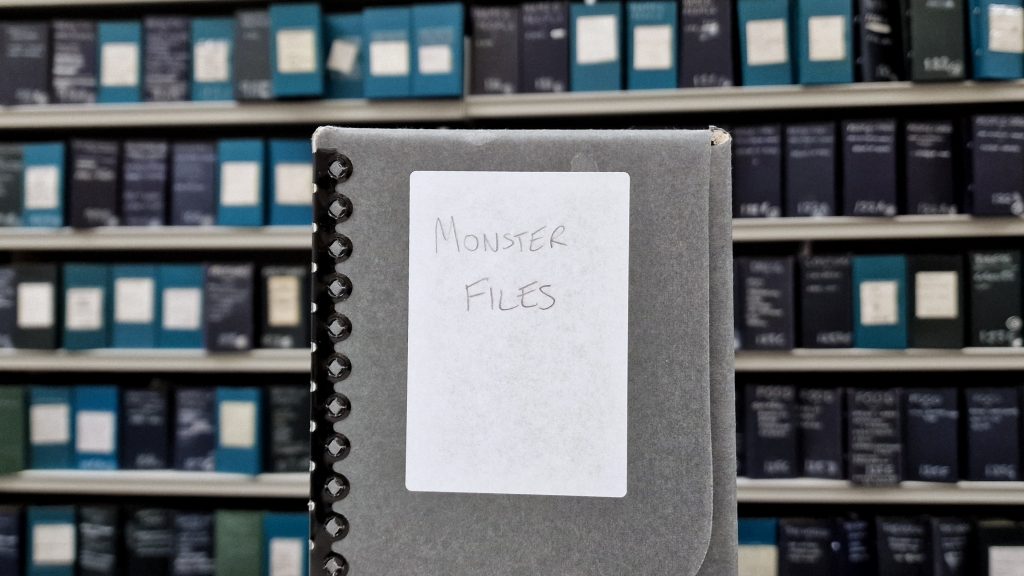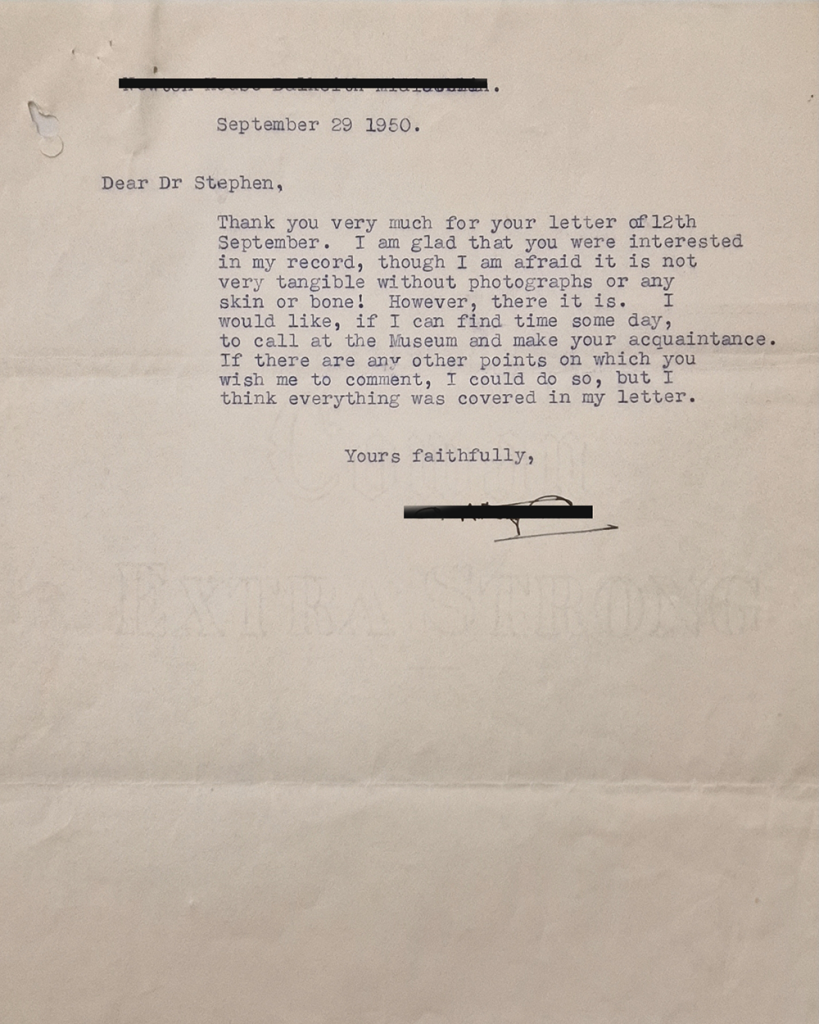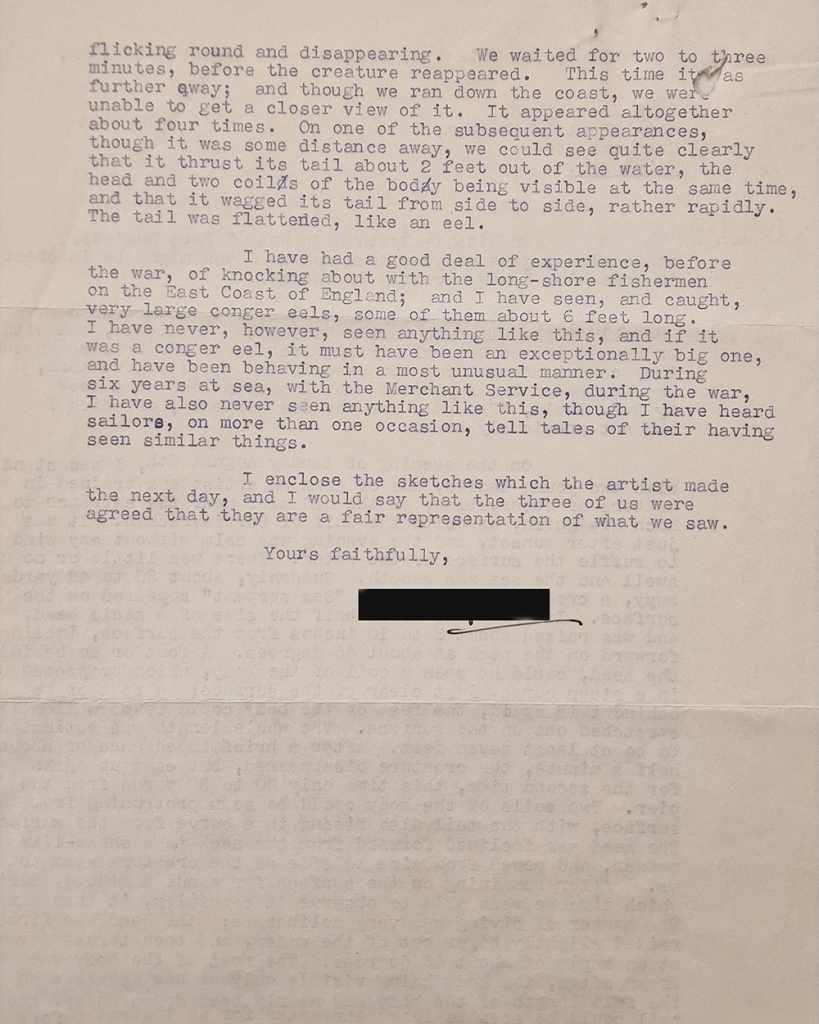Cryptozoology is the “search for and study of animals whose existence is disputed or unsubstantiated”, such as the elusive Loch Ness monster. Evidence of these creatures often turns out be a hoax, so April Fools Day feels like a good time to shine a light on something we don’t often talk about: our Monster Files.
Yes, you read that correctly. From devil dogs to sea serpents to the yeti, our Library Collection includes folder after folder of accounts and correspondence to our Keepers about these alleged monsters.
One of the most famous is the Loch Ness monster. Known as “Nessie”, the creature is the longstanding poster-monster for Scottish folklore. Alleged sightings go back many centuries, but it was a 1933 article in The Inverness Courier, about a large “beast” or “whale-like fish”, that really captured the world’s attention. The first sighting of 2022 happened just a few days ago!

Our collections reveal how over the years these fascinating sightings, theories and “evidence” demonstrate the hold these cryptids have had on our collective consciousness. And still do today.
Are you ready for a peek inside?

After delving into our Monster Files, we’ve selected a particular letter exchange from 1950. The initial correspondence is from a member of the public. They beautifully describe a strange sighting they witnessed, along with sketches, hoping our Keeper can shed light on the mysterious creature.
For very important X-Files types reasons, the name of the person writing in has been redacted. Enjoy this glimpse into our collections of the world of alleged monsters!
Letter 1: Loch Craignish monster sighting
Sent to Dr. A. C. Stephen, Keeper (Natural History Department).
August 29th 1950
Dear Sir,
Mr Ritchie Seath with whom I have business connections, gave me your name and said you might be interested in something I saw recently in the sea.
I have already been in correspondence with Dr Russell of the Plymouth Marine Biological Institute, and with Dr Fraser of the Natural History Section of the British Museum. They cannot account for the description which I gave them, and Dr Fraser has suggested that I have a look at a book by R.T. Gould, “The case for the Sea Serpent”, of which I had not previously heard.
On the evening of Sunday August 6th, I was standing with two young ladies, one of them an artist and trained in matters of observation, on the old pier near the entrance to Loch Craignish, opposite the Gulf of Corrievreckan. It was just after sunset, and the evening was calm without any wind to ruffle the surface of the water. There was little or no swell and the sea was smooth. Suddenly, about 30 to 40 yards away, a creature resembling a “Sea serpent” appeared on the surface. Its head was about half the size of a seals head, and was raised about 8 to 10 inches from the surface, inclined forward on the neck at about 45 degrees. A foot or so behind the head, could be seen a coil of the body, which projected in a steep curve, just clear of the surface; a foot or so behind this again, the rest of the body could be seen floating stretched out on the surface. The whole length was estimated to be at least seven feet. After a brief appearance of about half a minute, the creature disappeared, but came up again for the second time, this time only 20 to 30 yards from the pier. Two coils of the body could be seen protruding from the surface, with the tail also rising in a curve from the surface. The head was inclined forward from the neck in a snake-like manner, and moved from side to side as the creature swam towards us. After remaining on the surface for about a minute, during which time we were able to observe it carefully, it then dived. The manner of diving was very deliberate; the head was first raised slightly higher out of the water, and then thrust downward at an angle of about 45 degrees. The rest of the body was drawn after, the body being visible only at one apex; when the full length of the body had nearly been drawn under, the tail could be seen to leave the water for an instant before flicking round and disappearing. We waited for two to three minutes, before the creature reappeared. This time it was further away; and though we ran down the coast, we were unable to get a closer view of it. It appeared altogether about four times. On one of the subsequent appearances, though it was some distance away, we could see quite clearly that it thrust its tail about 2 feet out of the water, the head and two coils of the body being visible at the same time, and that it wagged its tail from side to side, rather rapidly. The tail was flattened, like an eel.

I have had a good deal of experience, before the war, of knocking about with the long-shore fishermen on the East Coast of England; and I have seen, and caught, very large conger eels, some of them about 6 feet long. I have never, however, seen anything like this, and if it was a conger eel, it must have been an exceptionally big one, and have been behaving in a most unusual manner. During six years at sea, with the Merchant Service, during the war, I have also never seen anything like this, though I have heard sailors, on more than one occasion, tell tales of their having seen similar things.
I enclose the sketches which the artist made the next day, and I would say that the three of us were agreed that they are a fair representation of what we saw.
Yours faithfully,
[redacted]
Letter 2: A rational, and inconclusive, explanation?
Keeper Dr. A. C. Stephen’s reply to [redacted].

12th September, 1950
Dear Sir,
I have received your letter of the 25th August, which has been following me around while I have been away on leave.
I am extremely interested in the description of your experience at Loch Craignish, but I am afraid I cannot help you very much to identify the creature you saw as I am not at all certain what animals these are which are being seen. I do not think they will prove to be any relics of the past, but of course there are still creatures in the sea we do not know about. It is possible the creatures you describe are some deep-sea fish like the Muraeid Eel. As you know, conditions in the Atlantic are quite abnormal and have been for a number of years. The herring fishing at Plymouth has failed and great faunistic changes have taken place, due to the flooding of the ground with open Atlantic water. Similarly, in Scotland, we have been seeing a number of rare creatures such as, for instance, the Mexican Turtle which arrived for the first time last year on our coasts, and also two specimens of the Giant Squid which has been known from the bank of Newfoundland and the open ocean. There is therefore quite a possibility that this may be another of these rare deep-sea creatures, but until a specimen is actually secured it is impossible to give any reasoned opinion.
Yours faithfully,
Keeper, Natural History Dept.
Letter 3: Case unsolved
Final letter from [redacted] to Dr A. C. Stephen.

September 29 1950
Dear Dr Stephen,
Thank you very much for your letter of 12th September. I am glad that you were interested in my record, though I am afraid it is not very tangible without photographs or any skin or bone! However, there it is. I would like, if I can find time some day, to call at the Museum and make your acquaintance. If there are any other points on which you wish me to comment, I could do so, but I think everything was covered in my letter.
Yours faithfully,
[redacted]
While sightings like the one presented above persist for decades, no convincing evidence has yet come to light. Even with modern technology (and regular Nessie sightings like this one) we’re still no closer to solving the mysteries of these evocative and tantalising creatures.
For some, this a clear case of mythology and wishful thinking. For others, the truth is out there. For now, we’ll leave you with the words of [redacted]: “there it is”.
If you enjoyed this post, let us know and we can offer some more glimpses into our Monster Files.


